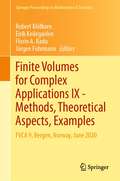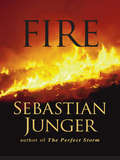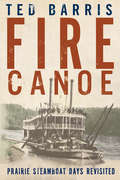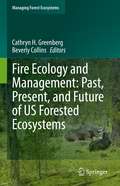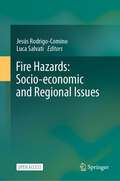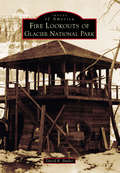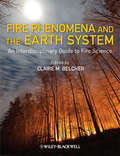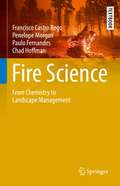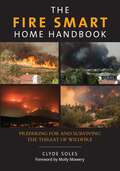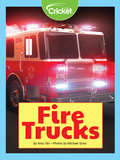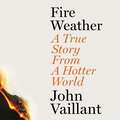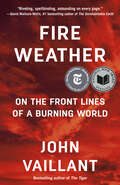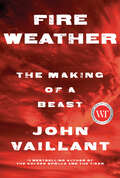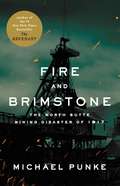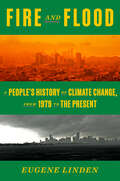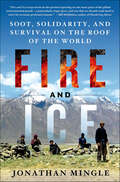- Table View
- List View
Finite Volume Methods for the Incompressible Navier–Stokes Equations (SpringerBriefs in Applied Sciences and Technology)
by Jian Li Zhangxing Chen Xiaolin LinThe book aims to provide a comprehensive understanding of the most recent developments in finite volume methods. Its focus is on the development and analysis of these methods for the two- and three-dimensional Navier-Stokes equations, supported by extensive numerical results. It covers the most used lower-order finite element pairs, with well-posedness and optimal analysis for these finite volume methods.The authors have attempted to make this book self-contained by offering complete proofs and theoretical results. While most of the material presented has been taught by the authors in a number of institutions over the past several years, they also include several updated theoretical results for the finite volume methods for the incompressible Navier-Stokes equations. This book is primarily developed to address research needs for students and academic and industrial researchers. It is particularly valuable as a research reference in the fields of engineering, mathematics, physics, and computer sciences.
Finite Volumes for Complex Applications IX - Methods, Theoretical Aspects, Examples: FVCA 9, Bergen, Norway, June 2020 (Springer Proceedings in Mathematics & Statistics #323)
by Jürgen Fuhrmann Robert Klöfkorn Eirik Keilegavlen Florin A. RaduThe proceedings of the 9th conference on "Finite Volumes for Complex Applications" (Bergen, June 2020) are structured in two volumes. The first volume collects the focused invited papers, as well as the reviewed contributions from internationally leading researchers in the field of analysis of finite volume and related methods. Topics covered include convergence and stability analysis, as well as investigations of these methods from the point of view of compatibility with physical principles. Altogether, a rather comprehensive overview is given on the state of the art in the field. The properties of the methods considered in the conference give them distinguished advantages for a number of applications. These include fluid dynamics, magnetohydrodynamics, structural analysis, nuclear physics, semiconductor theory, carbon capture utilization and storage, geothermal energy and further topics. The second volume covers reviewed contributions reporting successful applications of finite volume and related methods in these fields. The finite volume method in its various forms is a space discretization technique for partial differential equations based on the fundamental physical principle of conservation. Many finite volume methods preserve further qualitative or asymptotic properties, including maximum principles, dissipativity, monotone decay of free energy, and asymptotic stability, making the finite volume methods compatible discretization methods, which preserve qualitative properties of continuous problems at the discrete level. This structural approach to the discretization of partial differential equations becomes particularly important for multiphysics and multiscale applications. The book is a valuable resource for researchers, PhD and master’s level students in numerical analysis, scientific computing and related fields such as partial differential equations, as well as engineers working in numerical modeling and simulations.
Finn's Just-Right World
by Charnan SimonFinn is bored! She is stuck inside with her family because of the cold weather. While she tries to convince her family to go to the zoo, her brother tries to teach her about global warming. When Finn is skeptical, her father decides to take the whole family to the zoo to teach them about greenhouse gases and their effect on Earth.
Fire
by Sebastian JungerForest fires, terrorism, war: explorations of danger by the author of The Perfect Storm. For readers and viewers of The Perfect Storm, opening this long-awaited new work by Sebastian Junger will be like stepping off the deck of the Andrea Gail and into the inferno of a fire burning out of control in the steep canyons of Idaho. Here is the same meticulous prose brought to bear on the inner workings of a terrifying elemental force; here is a cast of characters risking everything in an effort to bring that force under control. Few writers have been to so many desperate corners of the globe as has Sebastian Junger; fewer still have provided such starkly memorable evocations of characters and events. From the murderous mechanics of the diamond trade in Sierra Leone to the logic of guerrilla warfare in Afghanistan and the forensics of genocide in Kosovo, this new collection of Junger's nonfiction will take you places you wouldn't dream of going to on your own.
Fire Canoe: Prairie Steamboat Days Revisited
by Ted BarrisThe story of steamboating in the Canadian West comes to life in the voices of those aboard the vessels of the waterways of the Prairies. Their captains were seafaring skippers who had migrated inland. Their pilots were indigenous people who could read the shoals, sandbars, and currents of Prairie waterways. Their operators were businessmen hoping to reap the benefits of commercial enterprise along the shores and banks of Canada’s inland lakes and rivers. Their passengers were fur traders, adventure-seekers, and immigrants opening up the West. All of them sought their futures and fortunes aboard Prairie steamboats, decades before the railways arrived and took credit for the breakthrough. Aboriginal people called them “fire canoes,” but in the latter half of the nineteenth century, their operators promoted them as Mississippi-type steamship queens delivering speedy transport, along with the latest in technology and comfort. Then, as the twentieth century dawned, steamboats and their operators adapted. They launched smaller, more tailored steamers and focused on a new economy of business and pleasure in the West. By day their steamboats chased freight, fish, lumber, iron ore, real estate, and gold-mining contracts. At night, they brought out the Edwardian finery, lights, and music to tap the pleasure-cruise market.
Fire Ecology and Management: Past, Present, and Future of US Forested Ecosystems (Managing Forest Ecosystems #39)
by Beverly Collins Cathryn H. GreenbergThis edited volume presents original scientific research and knowledge synthesis covering the past, present, and potential future fire ecology of major US forest types, with implications for forest management in a changing climate. The editors and authors highlight broad patterns among ecoregions and forest types, as well as detailed information for individual ecoregions, for fire frequencies and severities, fire effects on tree mortality and regeneration, and levels of fire-dependency by plant and animal communities. The foreword addresses emerging ecological and fire management challenges for forests, in relation to sustainable development goals as highlighted in recent government reports. An introductory chapter highlights patterns of variation in frequencies, severities, scales, and spatial patterns of fire across ecoregions and among forested ecosystems across the US in relation to climate, fuels, topography and soils, ignition sources (lightning or anthropogenic), and vegetation. Separate chapters by respected experts delve into the fire ecology of major forest types within US ecoregions, with a focus on the level of plant and animal fire-dependency, and the role of fire in maintaining forest composition and structure. The regional chapters also include discussion of historic natural (lightning-ignited) and anthropogenic (Native American; settlers) fire regimes, current fire regimes as influenced by recent decades of fire suppression and land use history, and fire management in relation to ecosystem integrity and restoration, wildfire threat, and climate change. The summary chapter combines the major points of each chapter, in a synthesis of US-wide fire ecology and forest management into the future.This book provides current, organized, readily accessible information for the conservation community, land managers, scientists, students and educators, and others interested in how fire behavior and effects on structure and composition differ among ecoregions and forest types, and what that means for forest management today and in the future.
Fire Escape: How Animals and Plants Survive Wildfires (Books for a Better Earth)
by Jessica StremerA timely middle grade nonfiction overview of the incredible ways animals detect, respond, and adapt to wildfires, as well as how climate change is affecting the frequency and severity of these devastating events in nature.Goats and beavers. Drones and parachutes. Pinecones and beetles. What do they have in common? Believe it or not, they are all crucial tools in fighting, preventing, and adapting to wildfires!These vicious fires are spreading faster and burning hotter than at any other time in history. Ongoing droughts, warming weather, and a history of poor forest management have extended the traditional wildfire season beyond the summer months. It is a matter of life and death for wildlife worldwide.This breathtaking nonfiction book focuses on unique angles to a hot topic, including injury rehabilitation efforts, species that use wildfires to their advantage, how to help area repopulation, and the animals that help to prevent/fight wildfires. A riveting, kid friendly text is accompanied by stunning woodcut illustrations and full-color photographs, as well as extensive back matter with glossary, sources, and index.Books for a Better Earth are designed to inspire children to become active, knowledgeable participants in caring for the planet they live on.A Junior Library Guild Gold Standard Selection
Fire Hazards: Socio-economic and Regional Issues
by Jesús Rodrigo-Comino Luca SalvatiThe open access book aims to show the readers novel, relevant and reproducible power of synergistic collaborations between European research groups and stakeholders with the objective to synthesize the existing knowledge and expertise about fire management and hazard and defining a concerted research agenda that promotes an integrated approach to create fire-resilient landscapes, taking into account biological, biochemical and physical, but also socio-economic, historical, geographical, sociological, perception and policy constraints. This is an urgent societal need due to the expected further intensification and geographical spreading of wildfire regimes under Global Change. Fire has been part of the Earth's System for the last 400 million years, and humans are the sole species that controls and manages fire. We have used fire for over a million years, both, as hunter-gatherers managing the landscape with fire and as farmers using fire as a low-cost, efficient and ecological tool for clearing and maintaining the productivity of the land. Fire has been highlighted as the most influential element in the development of human societies. The increase in prolonged dry and hot periods observed in many regions of the world is exacerbating the risk of fire. The causes of increased fire risk are not only linked to climate change but are also a consequence of economic and social changes and political decisions. Over the past few decades, many countries’ rural areas have seen significant depopulation and a reduction in land management as residents moved to cities or even other countries in search of work. The resulting rural depopulation has led to revegetation of the abandoned agricultural land, which favors fire spread. The enhanced risk of fires is moving beyond the capacity of even the best-funded wildland firefighting teams and therefore calls for the development of new approaches to fire management that are key nowadays at different scales. Instead of focusing primarily on increasing firefighting capabilities, a more effective approach is needed that focuses on long-term fire prevention through vegetation management by reducing fuel load or managing fuel type and fuel continuity at a landscape level. FIRElinks (COST Action CA18135) is developing the EU-spanning network of scientists and practitioners involved in forest fire research and land management with backgrounds such as fire dynamics, fire risk management, fire effects on vegetation, fauna, soil and water and socio-economic, historical, geographical, political perception and land management approaches. Among the different Working Groups, number 5 is aimed to connect communities from different scientific and geographic backgrounds, allowing the discussion of different experiences and the emergence of new approaches to fire research, human management, regional issues and socio-economic aspects.
Fire Lookouts of Glacier National Park
by David R. ButlerThe first fire lookouts in the Glacier National Park region were simply high points atop mountain peaks with unimpeded views of the surrounding terrain. Widespread fires in the 1910s and 1920s led to the construction of more permanent lookouts, first as wooden pole structures and subsequently as a variety of one- and two-story cabin designs. Cooperating lookouts in Glacier Park, the Flathead National Forest, and the Blackfeet Indian Reservation provided coverage of forests throughout Glacier National Park. Beginning in the 1950s, many of the lookouts were decommissioned and eventually destroyed. This volume tells the story of the rise and fall of the extensive fire lookout network that protected Glacier National Park during times of high fire danger, including lookouts still operating today.
Fire Management in the American West
by Mark HudsonMost journalists and academics attribute the rise of wildfires in the western United States to the USDA Forest Service's successful fire-elimination policies of the twentieth century. However, in Fire Management in the American West, Mark Hudson argues that although a century of suppression did indeed increase the hazard of wildfire, the responsibility does not lie with the USFS alone. The roots are found in the Forest Service's relationships with other, more powerful elements of society--the timber industry in particular. Drawing on correspondence both between and within the Forest Service and the major timber industry associations, newspaper articles, articles from industry outlets, and policy documents from the late 1800s through the present, Hudson shows how the US forest industry, under the constraint of profitability, pushed the USFS away from private industry regulation and toward fire exclusion, eventually changing national forest policy into little more than fire policy. More recently, the USFS has attempted to move beyond the policy of complete fire suppression. Interviews with public land managers in the Pacific Northwest shed light on the sources of the agency's struggles as it attempts to change the way we understand and relate to fire in the West. Fire Management in the American West will be of great interest to environmentalists, sociologists, fire managers, scientists, and academics and students in environmental history and forestry.
Fire Management in the American West: Forest Politics and the Rise of Megafires (G - Reference, Information And Interdisciplinary Subjects Ser.)
by Mark HudsonMost journalists and academics attribute the rise of wildfires in the western United States to the USDA Forest Service's successful fire-elimination policies of the twentieth century. However, in Fire Management in the American West, Mark Hudson argues that although a century of suppression did indeed increase the hazard of wildfire, the responsibility does not lie with the USFS alone. The roots are found in the Forest Service's relationships with other, more powerful elements of society--the timber industry in particular. Drawing on correspondence both between and within the Forest Service and the major timber industry associations, newspaper articles, articles from industry outlets, and policy documents from the late 1800s through the present, Hudson shows how the US forest industry, under the constraint of profitability, pushed the USFS away from private industry regulation and toward fire exclusion, eventually changing national forest policy into little more than fire policy. More recently, the USFS has attempted to move beyond the policy of complete fire suppression. Interviews with public land managers in the Pacific Northwest shed light on the sources of the agency's struggles as it attempts to change the way we understand and relate to fire in the West. Fire Management in the American West will be of great interest to environmentalists, sociologists, fire managers, scientists, and academics and students in environmental history and forestry.
Fire Phenomena and the Earth System: An Interdisciplinary Guide to Fire Science
by Claire M. BelcherFire plays a key role in Earth system processes. Wildfires influence the carbon cycle and the nutrient balance of our planet, and may even play a role in regulating the oxygen content of our atmosphere. The evolutionary history of plants has been intimately tied to fire and this in part explains the distribution of our ecosystems and their ability to withstand the effects of natural fires today. Fire Phenomena and the Earth System brings together the various subdisciplines within fire science to provide a synthesis of our understanding of the role of wildfire in the Earth system. The book shows how knowledge of fire phenomena and the nature of combustion of natural fuels can be used to understand modern wildfires, interpret fire events in the geological record and to understand the role of fire in a variety of Earth system processes. By bringing together chapters written by leading international researchers from a range of geological, environmental, chemical and engineering disciplines, the book will stimulate the exchange of ideas and knowledge across these subject areas. Fire Phenomena and the Earth System provides a truly interdisciplinary guide that can inform us about Earth’s past, present and beyond. Readership: Advanced students and researchers across a wide range of earth, environmental and life sciences, including biogeochemistry, paleoclimatology, atmospheric science, palaeontology and paleoecology, combustion science, ecology and forestry.
Fire Prevention Applications
by Brett Lacey Paul ValentineThis NEW updated text presents fire prevention methods for comprehensive risk reduction strategies in detail. Community coalition building to solve present-day community risk challenges is emphasized. <p><p>The book meets the FESHE model Fire Prevention Organization and Management course. It can be used as a guide to implement a modern fire prevention and risk reduction program. It also provides fire prevention organizational structures, staffing options; with emphasis on successfully overcoming the challenges fire prevention and risk reduction bureaus face today.
Fire Science: From Chemistry to Landscape Management (Springer Textbooks in Earth Sciences, Geography and Environment)
by Francisco Castro Rego Paulo Fernandes Penelope Morgan Chad HoffmanThis textbook provides students and academics with a conceptual understanding of fire behavior and fire effects on people and ecosystems to support effective integrated fire management. Through case studies, interactive spreadsheets programmed with equations and graphics, and clear explanations, the book provides undergraduate, graduate, and professional readers with a straightforward learning path. The authors draw from years of experience in successfully teaching fundamental concepts and applications, synthesizing cutting-edge science, and applying lessons learned from fire practitioners. We discuss fire as part of environmental and human health. Our process-based, comprehensive, and quantitative approach encompasses combustion and heat transfer, and fire effects on people, plants, soils, and animals in forest, grassland, and woodland ecosystems from around the Earth. Case studies and examples link fundamental concepts to local, landscape, and global fire implications, including social-ecological systems. Globally, fire science and integrated fire management have made major strides in the last few decades. Society faces numerous fire-related challenges, including the increasing occurrence of large fires that threaten people and property, smoke that poses a health hazard, and lengthening fire seasons worldwide. Fires are useful to suppress fires, conserve wildlife and habitat, enhance livestock grazing, manage fuels, and in ecological restoration. Understanding fire science is critical to forecasting the implication of global change for fires and their effects. Increasing the positive effects of fire (fuels reduction, enhanced habitat for many plants and animals, ecosystem services increased) while reducing the negative impacts of fires (loss of human lives, smoke and carbon emissions that threaten health, etc.) is part of making fires good servants rather than bad masters.
Fire Smart Home Handbook: Preparing for and Surviving the Threat of Wildfire
by Clyde SolesAs climate change continues to wreak havoc on the environment, devastating wildfires, both natural and manmade, are increasing. The figure for average acres burned has increased from almost 2 million acres in 1992 to nearly 7 million in 2012, which set a new record with an average of 165 acres burned per fire. Things are heating up, but global warming isn&’t the only problem. Budgets for fire suppression have been slashed severely. The number of air tankers has decreased from 44 in 2002 to just 9 in 2012, which means fast attacks on fledgling fires will grow more difficult in the future. If you live in a wildland-urban interface, the zone between unoccupied and developed land, sooner or later fire will happen. Fortunately you can prepare for the worst, and it doesn&’t have to cost a fortune. This highly detailed and practical reference guide will help you live more safely in the red zone and save you time and money along the way, providing multiple methods of risk mitigation along with the financial level of each action. Effectively prepping your land can even enhance the scenery and increase the value of your home. Learn how wildfires begin and behave, how to evaluate your property, what essential tools you&’ll need and what they will cost, how to prepare your land and home—including tips on how to avoid insurance nightmares—when to stay and fight, when it&’s time to evacuate, how to clean up after a fire event, and more. Even if you live in the middle of a suburb, the information on how fires start and spread and how to deal with insurance claims will prove enlightening and helpful. No one can guarantee that your house or land will survive if a major conflagration erupts, but you can greatly improve your odds with this book and a little preparation.
Fire Trucks
by Amy TaoFirefighter Greg has an important job to do–he helps people who are in danger of being hurt by fire. He has a lot of equipment to help him do his job. A computer inside the fire truck shows Firefighter Greg exactly which house to go to. Ladders, rigs, and tools help get the job done! Can you name other equipment that will be needed for Firefighter Greg to help others, and be safe? How can you be safe at your house to prevent fires?
Fire Weather: A True Story from a Hotter World
by John VaillantA stunning account of this century's most intense urban fire, and a panoramic exploration of the rapidly changing relationship between fire and humankind. In May 2016, Fort McMurray, Alberta, the hub of Canada's oil industry, was overrun by wildfire. The multi-billion-dollar disaster turned entire neighbourhoods into firebombs and drove 90,000 people from their homes in a single afternoon. Through the story of this apocalyptic conflagration, John Vaillant explores the past and the future of our ever-hotter, more flammable world.For hundreds of millennia, fire has been a partner in our evolution, shaping culture and civilization. Yet in our age of intensifying climate change, we are seeing its destructive power unleashed in ways never before witnessed by human beings. With masterly prose and cinematic style, Vaillant delves into the intertwined histories of the oil industry and climate science, the unprecedented devastation wrought by modern wildfires, and the lives forever changed by these disasters. Fire Weather is an urgent book for our new century of fire.'John Vaillant is one of the great poetic chroniclers of the natural world' David Wallace-Wells'A towering achievement; an immense work of research, reflection and imagination' Robert Macfarlane(P) 2023 Penguin Audio
Fire Weather: A True Story from a Hotter World
by John Vaillant'Astounding on every page. John Vaillant is one of the great poetic chroniclers of the natural world' David Wallace-Wells'A towering achievement; an immense work of research, reflection and imagination' Robert MacfarlaneA gripping account of this century's most intense urban fire, and a panoramic exploration of the rapidly changing relationship between humanity and fire's fierce energy.In May 2016, Fort McMurray, Alberta, the hub of Canada's oil industry, was overrun by wildfire. The multi-billion-dollar disaster turned entire neighbourhoods into firebombs and drove 90,000 people from their homes in a single afternoon. Through the story of this apocalyptic conflagration, John Vaillant explores the past and the future of our ever-hotter, more flammable world.For hundreds of millennia, fire has been a partner in our evolution, shaping culture and civilization. Yet in our age of intensifying climate change, we are seeing its destructive power unleashed in ways never before witnessed by human beings. With masterly prose and cinematic style, Vaillant delves into the intertwined histories of the oil industry and climate science, the unprecedented devastation wrought by modern wildfires, and the lives forever changed by these disasters. Fire Weather is urgent reading for our new century of fire.
Fire Weather: On the Front Lines of a Burning World
by John VaillantPULITZER PRIZE FINALIST • A NEW YORK TIMES TOP TEN BOOK OF THE YEAR • FINALIST FOR THE NATIONAL BOOK AWARD IN NONFICTION • A stunning account of a colossal wildfire and a panoramic exploration of the rapidly changing relationship between fire and humankind from the award-winning, best-selling author of The Tiger and The Golden Spruce • Winner of the Baillie Gifford Prize for Non-FictionA BEST BOOK OF THE YEAR: The New York Times, The Washington Post, The New Yorker, TIME, NPR, Slate, and Smithsonian&“Grips like a philosophical thriller, warns like a beacon, and shocks to the core." —Robert Macfarlane, bestselling author of Underland&“Riveting, spellbinding, astounding on every page.&” —David Wallace-Wells, #1 bestselling author of The Uninhabitable EarthIn May 2016, Fort McMurray, the hub of Canada&’s oil industry and America&’s biggest foreign supplier, was overrun by wildfire. The multi-billion-dollar disaster melted vehicles, turned entire neighborhoods into firebombs, and drove 88,000 people from their homes in a single afternoon. Through the lens of this apocalyptic conflagration—the wildfire equivalent of Hurricane Katrina—John Vaillant warns that this was not a unique event, but a shocking preview of what we must prepare for in a hotter, more flammable world.Fire has been a partner in our evolution for hundreds of millennia, shaping culture, civilization, and, very likely, our brains. Fire has enabled us to cook our food, defend and heat our homes, and power the machines that drive our titanic economy. Yet this volatile energy source has always threatened to elude our control, and in our new age of intensifying climate change, we are seeing its destructive power unleashed in previously unimaginable ways.With masterly prose and a cinematic eye, Vaillant takes us on a riveting journey through the intertwined histories of North America&’s oil industry and the birth of climate science, to the unprecedented devastation wrought by modern forest fires, and into lives forever changed by these disasters. John Vaillant&’s urgent work is a book for—and from—our new century of fire, which has only just begun.
Fire Weather: The Making of a Beast
by John Vaillant#1 NATIONAL BESTSELLERWINNER OF THE BAILLIE GIFFORD PRIZE FOR NONFICTION • FINALIST FOR THE HILARY WESTON WRITERS' TRUST PRIZE FOR NONFICTION • FINALIST FOR THE NATIONAL BOOK AWARD IN NONFICTION • ONE OF THE NEW YORK TIMES&’ TOP TEN BOOKS OF THE YEAR • A stunning account of the colossal wildfire at Fort McMurray, and a panoramic exploration of the rapidly changing relationship between fire and humankind from the award-winning, best-selling author of The Tiger and The Golden Spruce.Named a Best Book of the Year by The Guardian • TIME • The Globe and Mail • The New Yorker • Financial Times • CBC • Smithsonian • Air Mail Weekly • Slate • NPR • Toronto Star • The Washington Post • The Times • Orion MagazineIn May 2016, Fort McMurray, the hub of Canada's petroleum industry and America's biggest foreign supplier, was overrun by wildfire. The multi-billion-dollar disaster melted vehicles, turned entire neighborhoods into firebombs, and drove 88,000 people from their homes in a single afternoon. Through the lens of this apocalyptic conflagration—the wildfire equivalent of Hurricane Katrina—John Vaillant warns that this was not a unique event but a shocking preview of what we must prepare for in a hotter, more flammable world. For hundreds of millennia, fire has been a partner in our evolution, shaping culture, civilization, and, very likely, our brains. Fire has enabled us to cook our food, defend and heat our homes, and power the machines that drive our titanic economy. Yet this volatile energy source has always threatened to elude our control, and in our new age of intensifying climate change, we are seeing its destructive power unleashed in previously unimaginable ways. With masterly prose and a cinematic eye, Vaillant takes us on a riveting journey through the intertwined histories of North America's oil industry and the birth of climate science, to the unprecedented devastation wrought by modern forest fires, and into lives forever changed by these disasters. John Vaillant's urgent work is a book for—and from—our new century of fire, which has only just begun.
Fire and Brimstone
by Michael PunkeThere is a sign that appears to point persistently to a terrible explosion underground. -HOROSCOPE PRINTED IN THE ANACONDA STANDARD, JUNE 5, 1917
Fire and Brimstone: The North Butte Mining Disaster of 1917
by Michael PunkeThe author of the #1 New York Times bestseller, The Revenant--basis for the award-winning motion picture starring Leonardo DiCaprio--tells the remarkable story of the worst hard-rock mining disaster in American history. The worst hard-rock mining disaster in American history began a half hour before midnight on June 8, 1917, when fire broke out in the North Butte Mining Company's Granite Mountain shaft. Sparked more than two thousand feet below ground, the fire spewed flames, smoke, and poisonous gas through a labyrinth of underground tunnels. Within an hour, more than four hundred men would be locked in a battle to survive. Within three days, one hundred and sixty-four of them would be dead.Fire and Brimstone recounts the remarkable stories of both the men below ground and their families above, focusing on two groups of miners who made the incredible decision to entomb themselves to escape the gas. While the disaster is compelling in its own right, Fire and Brimstone also tells a far broader story striking in its contemporary relevance. Butte, Montana, on the eve of the North Butte disaster, was a volatile jumble of antiwar protest, an abusive corporate master, seething labor unrest, divisive ethnic tension, and radicalism both left and right. It was a powder keg lacking only a spark, and the mine fire would ignite strikes, murder, ethnic and political witch hunts, occupation by federal troops, and ultimately a battle over presidential power.
Fire and Flood: A People's History of Climate Change, from 1979 to the Present
by Eugene LindenFrom a writer and expert who has been at the center of the fight for more than thirty years, a brilliant, big-picture reckoning with our shocking failure to address climate change. Fire and Flood focuses on the malign power of key business interests, arguing that those same interests could flip the story very quickly—if they can get ahead of a looming economic catastrophe.Eugene Linden wrote his first story on climate change, for Time magazine, in 1988; it was just the beginning of his investigative work, exploring all ramifications of this impending disaster. Fire and Flood represents his definitive case for the prosecution as to how and why we have arrived at our current dire pass, closing with his argument that the same forces that have confused the public&’s mind and slowed the policy response are poised to pivot with astonishing speed, as long-term risks have become present-day realities and the cliff&’s edge is now within view. Starting with the 1980s, Linden tells the story, decade by decade, by looking at four clocks that move at different speeds: the reality of climate change itself; the scientific consensus about it, which always lags reality; public opinion and political will, which lag further still; and, perhaps most important, business and finance. Reality marches on at its own pace, but the public will and even the science are downstream from the money, and Fire and Flood shows how devilishly effective moneyed climate-change deniers have been at slowing and even reversing the progress of our collective awakening. When a threat means certain but future disaster, but addressing it means losing present-tense profit, capitalism&’s response has been sadly predictable. Now, however, the seasons of fire and flood have crossed the threshold into plain view. Linden focuses on the insurance industry as one loud canary in the coal mine: fire and flood zones in Florida and California, among other regions, are now seeing what many call &“climate redlining.&” The whole system is teetering on the brink, and the odds of another housing collapse, for starters, are much higher than most people understand. There is a path back from the cliff, but we must pick up the pace. Fire and Flood shows us why, and how.
Fire and Ice: Soot, Solidarity, and Survival on the Roof of the World
by Jonathan MingleHigh in the Himalayan valley of Zanskar in northwest India sits a village as isolated as the legendary Shangri-La. Long fed by runoff from glaciers and lofty snowfields, Kumik—a settlement of thirty nine mud brick homes—has survived and thrived in one of the world's most challenging settings for a thousand years. But now its people confront an existential threat: chronic, crippling drought, which leaves the village canal dry and threatens to end their ancient culture of farming and animal husbandry. Fire and Ice weaves together the story of Kumik's inspiring response to this calamity with the story of black carbon. Black carbon from inefficient fires - the particulate residue that makes soot dark - is the second largest contributor to global warming after carbon dioxide. It's also a key ingredient of the air pollution that public health experts regard as humanity's greatest environmental health risk worldwide: soot-laden smoke from household hearth fires and outdoor sources combine to kill over seven million people around the world every year. Jonathan Mingle describes the joys and struggles of daily life in the Zanskar Valley, where villagers are buffeted by powerful environmental and economic forces, while also tracing black carbon's dark fingerprints outward from Kumik and around the world. Mingle investigates its impacts on snow, ice, and water from Mt. Everest to California, and the silent health epidemic it fuels from New York to New Delhi. Combining cultural history, detailed reportage, climate and energy science and dramatic storytelling, Fire and Ice is a profound examination of the global challenges of averting climate chaos and lifting billions out of energy poverty and water scarcity. Can Kumik's people come together to reinvent fire, harness what remains of their life-sustaining ice, and reinvigorate their traditions of solidarity, in time to save themselves? Can the rest of us rise to the same challenge? Fire and Ice connects these questions with the work of enterprising scientists, engineers, entrepreneurs and activists around the world, in a narrative that combines mythology, reason, humor, persistence, and hope in a race against a global clock.
Fire and Rain: California’s Changing Weather and Climate
by Stephen LaDochy Michael WitiwThis book shows how California’s weather and climate have drastically changed and what we can expect in the near future. California’s weather and climate are becoming as common a topic in the media as inflation and wars. It comes into our lives during heat waves when we require more cooling and during droughts when we are asked to limit our use of water. We may not be able to visit state and national parks when fires rage nearby. Indeed, California does have weather. LaDochy and Witiw dispel the erroneous myths about the state’s climate in a colorful, entertaining way. California does have seasons. It does rain in Southern California. It is not always sunny and mild throughout the year. And not all El Niños bring abundant rainfall every time throughout the state. These and other myths are discussed and dismissed with the latest science and remarkable vignettes. The authors describe the diversity of the state’s physical environment, both natural and man-made and how climate change is currently altering this diverse environment. Climate change, in the past, present and future, continues to influence this most populous state. Yes, California does have weather.

